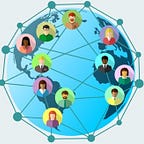Help Wanted: Dispersed network leaders — only the passionate need apply!
Kerstin Tebbe, Founder, Collective Mind
Ah, leadership. We have books, articles, podcasts, and blogs by the gazillions on the topic. But you guessed it: network leadership isn’t your typical, “traditional organization” leadership. Network leadership has to be as fit-for-purpose as with everything else in networks. And it’s not just leadership style that’s different in networks, the structure of leadership is different too.
Networks don’t have a clear chain of command — instead, they rely more on informal power through interpersonal relationships. Imagine a network map with dots everywhere and all the lines between them.
While some network actors may have formal roles — like staff that manage coordination and communications for the network — any number of network members will be acting in a range of roles at any given time. The table below defines a number of roles within a network:
It’s clear that in fact, we need a whole bunch of people doing a whole bunch of things to keep the network alive and afloat, often in informal roles, not formal positions other than network “member”.
If we want people playing many roles across the network, how do we facilitate that?
We decentralize and disperse the network’s leadership.
Leadership in a network spans the network; it isn’t centralized within a specific leader or even a leadership team. That’s both because any one person or team can’t fulfill all the requisite roles and because dispersed leadership is the means to relevance and sustainability for a network. More leaders working in a synergized manner can make the network more resilient, drive its work forward, and broaden its impact.
So, how do we do dispersed leadership?
Dispersed leadership requires reframing leadership as collaborative or, according to Paul Schmitz (@PaulSchmitz1), author of “Everybody Leads”, “moving from an emphasis on the noun leader to an emphasis on the verb lead”.
According to Schmitz, leadership in this collaborative sense is three things:
Networks don’t exist without members: those members must be empowered not just to take on network tasks but to own those tasks and to play a role in the decision-making. Anyone in a network is potentially capable of taking on leadership. To facilitate this, leadership — as well as ownership and decision-making — should be broken up into manageable chunks and those nuggets distributed across the network.
We can cultivate as dispersed network leaders those extra-passionate people who are always raising their hands to do the network’s work, push the network forward, and expand what’s possible. When we identify those folks who are both a) genuine in their passion and commitment to the shared purpose and b) qualified to take on responsibilities, we’ve found our candidates. We empower those dispersed leaders by giving them a stake in network decision-making and ownership and supporting them to be accountable to the network.
For this edition, we looked at the following sources:
Everybody Leads: Building Leadership from the Community Up
Get Together (or see here for a good overview of the book’s substance)
Inter-Organizational Networks: A Review of the Literature to Inform Practice
Net Gains: A Handbook for Network Builders Seeking Social Change
